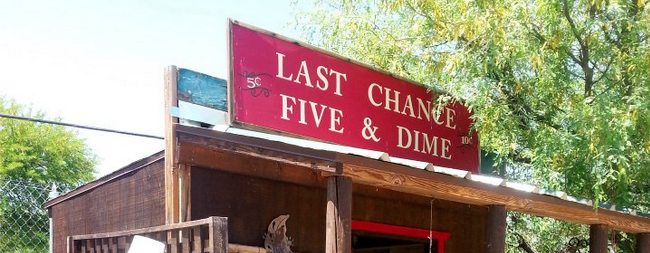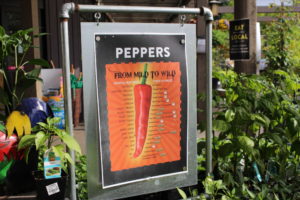
Creating Value for Horticulture … where it matters most
If your location is so good that you don’t have to be great (good luck with that), you’re in trouble. Companies with the best locations for retail traffic in the world are shaking in their boots. Why? Because online commerce is reducing the number of shopping trips consumers make. More people are working from home and commuting less. More people are ordering online and having the basics they once went out shopping for delivered to their door. You may not be doing this yet, but plenty of people are, and you’ll more than likely join them very soon. They’ll get your business later.
Meanwhile though, online sellers are after these shopping trips and they’re making a significant dent in their primary target your customer. They may not sell anything you do, but they are taking away store traffic events right and left in numbers that are growing so fast they can hardly count them accurately. Howard Shultz, founder and CEO of Starbucks, refers to this as a Seismic Shift. The number of stores where purchases are made on a shopping trip has dropped from over 5 to around 3 already. What if Starbucks is not on the remaining 3, or 2, or NEVER? You got it, the same thing that can happen to you.
By the way, Starbucks is not presently or planning in the future to ship or deliver your freshly crafted latte, cappuccino or Americano that I know of. Until the Amazon delivery drones are authorized by the FAA, it is unlikely that a drone/barista combination will be arriving to make these for you on your patio, deck, front porch or kitchen.
Staples has recently shifted its marketing focus away from its brick and mortar stores to its online store with their new vision and version of the Amazon Everything Store. War has been declared. The company has replaced the staple that formed the “L” in their name with a hammer and just about anything else you can imagine or can’t imagine. Staples is downsizing store footprints where business can’t be sustained and closing stores where landlords won’t cooperate to allow it to shed the now excess square footage. If physical store business drops too quickly, the remaining leases will be a noose around its neck that it won’t be able to get out of quick enough in the efforts to cut overhead and staff.
While we like to think garden centers are “destinations” for shopping, the new reality is that the world’s largest store is now the destination and it is as close as touching a fingertip on the omnipresent smart phone about three times.
Touch once to open the app.
Touch again to select an item.
Touch a third time to pay for it.
Oops, that purchasing touch takes two taps of the finger unless you’re buying from Amazon or another company who licensed their One-Click patent. OK, four clicks and you’re done … another shopping trip or visit to your store eliminated. Once a consumer does this, they do it again and again.
To sum it up, the fate of your business is already written if you’ll still be doing what you’re still doing right now tomorrow and the next day. This is worth repeating, but, rather than do that, let me put it in different terms to help you understand. To use a sports analogy, the ball is in motion and you had better be too if you’re going to be where it is going to have a chance at intercepting it. The ball will not be coming to you often enough for you to not lose. Game over.
There is one strategy to have a chance to survive for the long turn and it is called Omni-Channel retail. This means you will sell online and in your store. You’ll sell by voice telephone calls, by smart phone app, by website and by drones that knock on your door if the FAA will allow some visionary entrepreneur to do that. Did you hear that one company has already tried selling beer to ice fisherman in Minnesota delivered right to their home away from home on the ice on the lake? I’d imagine they have an off-season strategy to deliver beer and bait to the boat.
You who think Amazon and its kind aren’t going to sell your customers what you can you’re wrong. Better hedge your bets and find someone who will bet against me on this.
This is a situation that calls for Radical Investment in the future of your business. I’m not using the word “radical” for emphasis. I’m using it for your survival. Go big or go home.
Four Areas for Radical Investment
1. Become second place. Our “first place” is our home where we live. Our “second place” is where we work. Our “third place” is Cheers, or wherever it is you go that “everybody knows our name.” The world is changing and these places are changing with it. Your customers’ first place is still their home, but for many their second place has become their home where their office is also located. Many people (like me) are self-employed and working from home, and an increasing number of their employers prefer that they work from their home which means their first and second places are one in the same. This means their third place is now becoming their second place. What happens when your home and work become the same? You need a break. These computer-commuters need to get out to another place. And that place, or one of them, could be your store or it could be the store of your competitor.
So we’ve defined that it is important to not only recognize regular customers but also to know their name. Now we need to know what they need from their second place when they come out to it. While they’ve disconnected from their home office to share some time with you, they still must be connected to their workday. This is why major retailers provide free Wi-Fi connections. No, they’re not tying up a parking space, nor bringing their laptop and camping out all afternoon. Their smart phone silently, seamlessly and wirelessly connects and they’re still at work just in case the boss checks in.
What’s next? I don’t know but, as one of those people whose second place could be your place, I can tell you that I know it when you’re not my first (or second) second place. When you fail to make it convenient for me to stay connected to my work when I’m in your place, I can’t and therefore won’t be coming there much. Get the message?
2. Products. It is no longer competitive enough to be the same or to sell the same things that everyone else does. This is increasingly important as more and more brand-name products are sold in an omni-channel environment online, mobile, manufacturer’s retail showcases, in-store, QVC, by phone, fundraising groups you name it. Quality as an advantage is susceptible to the other guy increasing the quality they offer. To be different today and in the future you must actually be different.
Here are three ways to differentiate with the products you sell:
A. Signature Merchandise Sell what nobody else can, regardless of the price.
The basic ingredients of a Whopper are found in every restaurant in America, but you can buy a Whopper only at Burger King and everyone knows this. These SAME ingredients are available over at McDonald’s, but they can’t put the beef on an “Open Flame Grill.”
The exact same basic ingredients of a Whopper are integral to a Big Mac. But there is one ingredient of a Big Mac that cannot be found anywhere in America except at McDonald’s. You got it the “Special Sauce.” When you can sell something nobody else can regardless of the price you have a better opportunity. In comparison to Burger King, McDonald’s has taken the Big Mac all the way to the bank.
B. Mass Customization Convert basic products to one-offs for individual customer tastes and preferences.
When Burger King allows you to “Have it Your Way” by removing items from the basic Whopper and then allowing me to do the same they are “mass customizing.” Their burger making system supports this and they forced McDonald’s to convert to a similar system in order to do the same. When this point of differentiation evaporated, Burger King lost a critical edge and has failed to retain any meaningful competitive advantage other than specific location. When you create a system to customize basics you create a minor hurdle for other independent retailers, and a massive hurdle is built for box stores to overcome even with the help of your suppliers.
C. Treasure Hunt Experiences Why customers don’t know what they want.
Americans have become a culture of lookers “just lookers” to be specific. We have come to believe, and deservedly so, that salespeople are unprofessional, manipulative and pushy and therefore to be dealt with by lying to them. Is that a sad commentary on our culture or what?
We tell them that we are just looking when we very well know we are looking for something. Sometimes we’re looking for something specific, or for information, or for ideas, or for something we expect them to have but we and they don’t know what it is. Even if we’re looking for something specific, we also expect retailers to have something that cannot be described in any specific terms, although “we’ll know it when we see it.” If we don’t see what we don’t know we want, of course, we cannot buy it.
Striving to have something new, unique or unusual is still important and will continue to be. Having these items in the right amount and acquiring them without spending an arm and a leg in the pursuit is where the art and the science of being an effective merchant collide. How effective of a merchant can you become?
3. Know your customers better than you know your inventory. To serve customers we must know who they are and how they think. We must know what they want from us. We must be a customer expert first, and product experts second. All these years we thought we were supposed to be experts in our industry, and we were more wrong than we were right because we had them in the wrong order.
Now that we’ve arrived at the crossroads of industry expertise and computerization in our industry, we really need to put the computers to work to master not only the keeping track of money and our merchandise but also the keeping track of our customer relationships. In the “other world” of mass market retail, they refer to this as CRM (Customer Relationship Management). Unfortunately, many corporations use technology to use customer information against them. You may have read recently that Amazon has been awarded a patent for Anticipatory Shipping. Yes, they’ll ship based on what their customers can be presumptuously expected to buy.
A customer relationship doesn’t have to be sinister or manipulative. It should be built on respect in a caring, nurturing and helpful manner. That means we’ll put our customers in a position of higher importance than we put our knowledge, experience and staff.
Here’s a practical way to do this. I remember a few years ago I was in a staff meeting on a consultation session with McComb Gardens in Sequim, Wash. The meeting was underway, and we all heard a car pull into the driveway. Someone asked, “Who’s on the gravel today?” Perhaps the same thought went through your mind as did mine. Was someone lying injured in the driveway? Well, I knew that wasn’t the case, but what did this curious question mean?
Here’s what they meant. Each day there is a rotation of employees to be the first responder when a customer enters the property. They are listening for the sound of a customer vehicle entering the driveway and making their way to greet those customers appropriately. This way the other staff members stay focused on whatever they are doing at the moment whether that is helping another customer, receiving merchandise or attending to some task caring for the merchandise.
4. Associates. Is your company one of those that says your people are important, or one that just skips the platitudes and actually shows it? The way I see it you have two ways to provide service. Amazon is counting on their computer algorithms, programming, centralized copywriting, and other people’s products to sell and service their customers, which includes ALL of your customers by the way. So your customers will be used to that.
The trouble is the technology and capital to do what big companies like Amazon do are probably both out of your league. So unless I’m wrong and you’re in the league of being incredibly gifted with Jeff Bezos’ kind of brilliance or that you’ll be blessed financially with a big lottery payout, that leaves you with the other strategy, which is to employ and engage the vast abilities of the human brain running on inspired passion that you turn toward your customers instead of your staff. Now I’ll bet on you with this one.
Because your future is people dependent, you must have people who “think like customers think before they think what they’re about to think.” Developing this mindset in people is a chore, but it can be done both time and cost effectively. It is easier than developing the “think like owners before they think” mindset. Think about that.
Taking your company into the future is going to be very difficult, but you can do it. You’ve been given a human brain, and, if you’re reading this, I know you have the ability to read and some level of desire to learn. What I don’t know is if you have the will to win. I hope so but you’ll have to work harder than you’ve ever worked in your life to prove it. This time you’ll be working with your brain and your ability to develop vision. But that alone and $4 will get you a Starbucks. What you will really need is the people skills to develop new and unique associate, customer and supplier-partner relationships.


















 Videos
Videos





